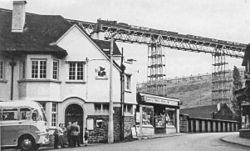Crumlin Viaduct | |
|---|---|
 Crumlin Viaduct in 1957 | |
| Coordinates | 51°40′49″N 3°08′23″W / 51.6804°N 3.1396°W |
| Carries | Taff Vale Extension |
| Crosses | Ebbw River |
| Locale | Monmouthshire |
| Owner | Newport, Abergavenny and Hereford Railway British Railways |
| Characteristics | |
| Material | Wrought iron, stone pillars and supports |
| Total length | 1,650 ft (502.9 m) (1,066 ft (324.9 m) + 584 ft (178.0 m)) |
| Height | 200 feet (61 m) Highest railway viaduct in the United Kingdom throughout its working life |
| Longest span | 150 feet (46 m) |
| No. of spans | 7 (Ebbw) + 3 (Kendon) |
| History | |
| Architect | Charles Liddell |
| Designer | Thomas W. Kennard |
| Engineering design by | Falkirk Iron Co |
| Fabrication by | Falkirk Iron Co |
| Construction start | 1853 |
| Construction end | 1857 |
| Construction cost | £62,000 (£41 7s per foot)[1] (£6.262m at 2014 prices)[2] |
| Opened | 1 June 1857 |
| Closed | 1964 |
| Location | |
 | |

The Crumlin Viaduct was a railway viaduct located above the village of Crumlin in South Wales, originally built to carry the Taff Vale Extension of the Newport, Abergavenny and Hereford Railway (NA&HR) across the Ebbw River.
Hailed as "one of the most significant examples of technological achievement during the Industrial Revolution",[3][4] in its 107 years of service until being dismantled in 1965, it remained: the least expensive bridge for its size ever constructed; the tallest railway viaduct in the United Kingdom;[3] the third tallest viaduct in the world, after the aqueduct at Spoleto, Italy, and the timber viaduct in Portage, New York state.[3]
- ^ Railway Magazine September 1957 pp. 647-649
- ^ Bank of England inflation calculator
- ^ a b c Cite error: The named reference
CaerpGovwas invoked but never defined (see the help page). - ^ "Crumlin Viaduct". RIBA. Archived from the original on 19 August 2012. Retrieved 5 October 2011.